Warm weather can be a challenging time for snowshoers. For most of us, the snow has retreated to high elevations and consolidated to make snowshoes unnecessary. In the Northwest U.S., snow levels are around 8,000 feet (2438 m), generally a few thousand feet above most trailheads. As a result, my snowshoes have been stored and left hanging in the garage, neglected in favor of trail runners and shorts.
But all is not lost! Snowshoes can serve double duty when you head to the beach or desert for a summer snowshoeing outing. Yes, beaches and deserts. You know, those hot places with sand.
Some of the links in this article may contain affiliate links. When you purchase using these links, part of the proceeds go to Snowshoe Mag. Additionally, as Amazon Associates, we earn from qualifying purchases. Please see our disclosure for more details.
Why Use Snowshoes on Sand?
Sand can swallow your feet, fill your shoes, and rub the skin right off your feet. Worse, the tricks we often use to keep snow out of our boots (like gaiters) seem less effective against sand. Plus, when the sand does get in, it won’t melt away. So how can we limit the amount of sand we get in our shoes?
Try using snowshoes! It’s unlikely Tubbs, Atlas, or other snowshoe companies will produce a line of sandshoes, but they might as well. Snowshoes work great on the sand. The crampons aren’t all that necessary because the coefficient of friction of sand is so much higher than snow. So, you’re not likely to slip much.
However, the real advantage of snowshoeing in a desert or beach in summer is that you limit sinking in the sand.
Read More: The Sandshoeing Experience: Will Snowshoes Work on Sand?
The Sandshoeing Experience
My kids and I decided to try snowshoeing on the sand in the summer, aka sandshoeing. My kids are 10, 8, and 6, and they have been snowshoeing for years. Our dog, Treen, is four years old, and she’s also experienced in the snow. In Washington, dunes are pretty isolated, so we had a few miles to hike through the scrub to get to the White Bluffs on the banks of the Columbia River. The White Bluffs, specifically the North Slope, are isolated dunes a few hundred feet above the river.
We started without our snowshoes. But, right away, I was sinking in the sand. The kids were, too. I had thought my kids would float more, but without sandshoes on, the sand was already filling their shoes.
So, they strapped into their snowshoes and headed across the dune. I followed, but since I carried all the gear through the desert, I had opted to leave my snowshoes/sandshoes at home—a big mistake.
Thanks to their shoes ‘ flotation, the kids could walk across the top of the sand. I struggled through it. It wasn’t quite post-holing, but it was certainly more tiring than walking on the surface.
We reached the windward side of the White Bluffs, facing the river. It’s a relatively gentle slope and is pretty well consolidated. However, I sank 4 inches (10 cm). The kids did not. The leeward side is much steeper and less consolidated. I sank between six and eight inches (15-20 cm). Again, the kids barely made a mark.
Read More: A Beginner’s Perspective: Breaking Trail on the Beach
Although no cornice was at the top of the dune, it was the least stable part of the slope. As we moved along the ridge, we triggered what would have been loose dry avalanches in the snow. It was an excellent opportunity to discuss avalanche safety and the warning signs with the kids again. (It’s never too early to start.)
With all these similarities to snow, I decided maybe the sled I had dragged along might not have been a wasted effort after all. Typically, I’d have started the kids down the most gentle slope until they begged for more speed. But we began along the ridge since it dropped off a cliff down to the river a few hundred feet below. Or at least we tried.
It turns out the reason a plastic sled works so well on snow is that the friction melts the snow and creates a lubricating layer of water. Since the melting point of sand (1700C) is a little bit higher than snow (0C), let alone the melting point of the sled (130C), we hardly moved at all.
Even on the steepest slope, nearly 60 degrees, the descent was more slow-motion than expected on snow. Not that the kids minded. To them, it was sledding. Even still, it could’ve been a little better since it wasn’t as cold–though a faceplant in the sand is much harder to recover from than in the snow.
Read More: Sandshoeing New Mexico’s White Sands National Park
Plan Your Sandshoeing Outing
So, if you go, leave the sled at home, but bring your snowshoes. If you’re going to be walking on sand for more than half a mile (0.8 km), they’ll be worth their weight. But, even if you’re not going that far, you should take snowshoes at least once to say you have tried it.
Also, when you go, I would recommend bringing a few other items, such as a shade shelter, a pad for the dog to sit on instead of the hot sand, and of course, lots and lots of water.
See you out on the dunes!
This article was first published on Sept 9, 2013, and most recently updated on May 23, 2023.
Read Next: Using Your Snowshoes on the Sand for Fitness

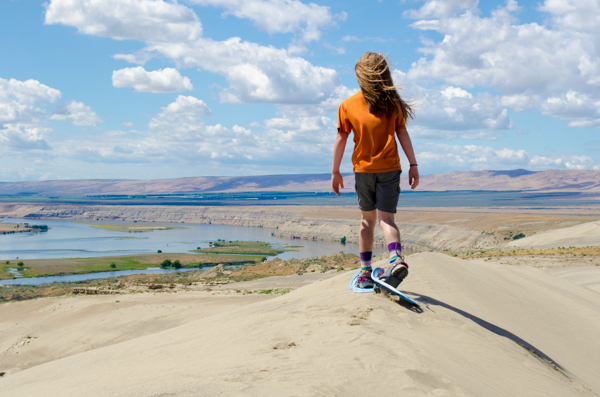
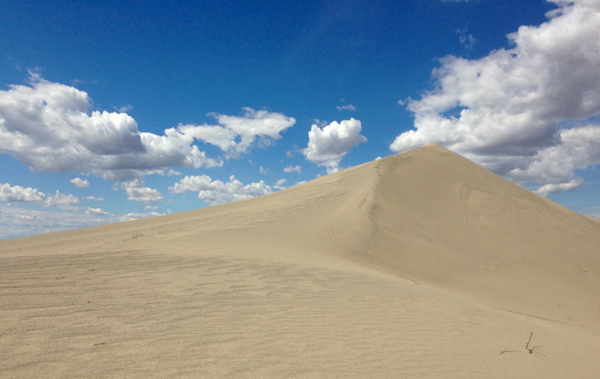
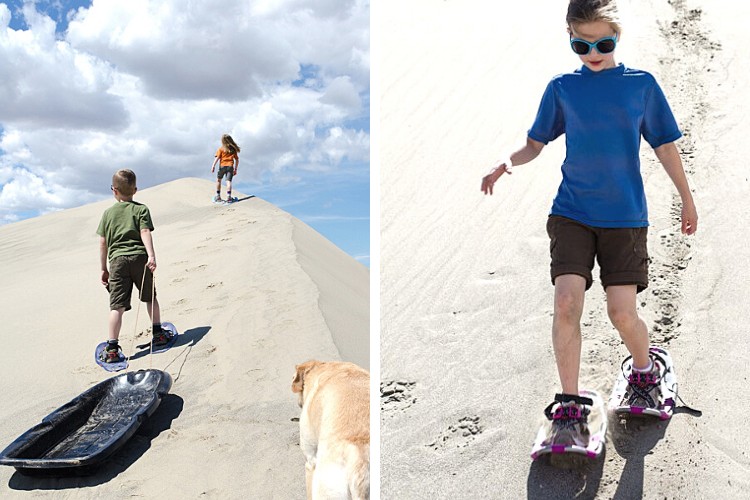
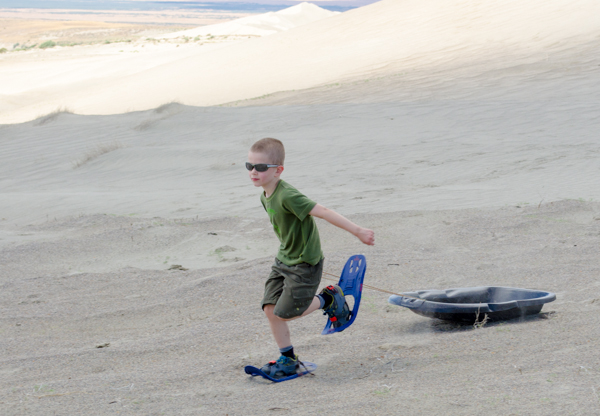
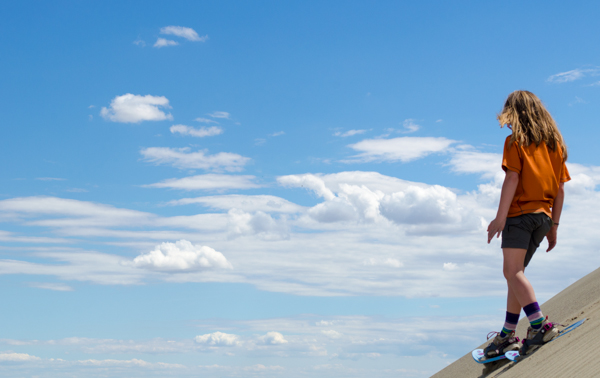
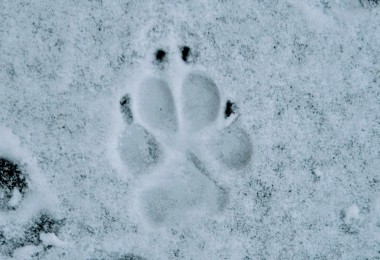
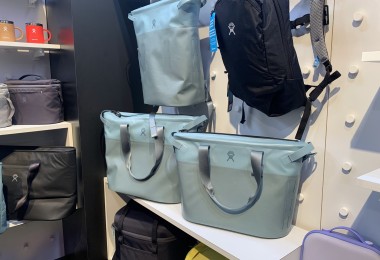
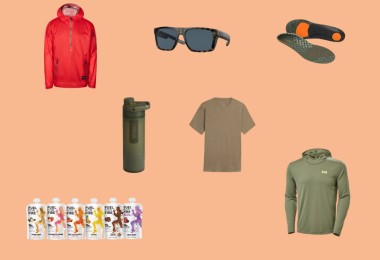
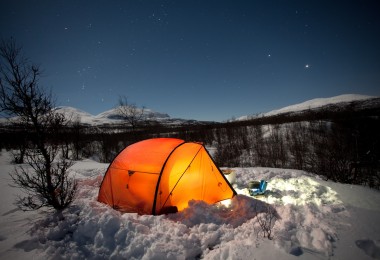

I live in Southern California. The beach at Santa Monica is lovely… But to access the water, you have to slog your way across a wide stretch of sand. And if you are carrying a tent, backpack, food, etc. for a day at the beach, the barrier becomes more than just daunting. I just don’t go. My legs get too tired.
I love the beach, and am wondering if snowshoes, or some variety thereof, might be the answer to my prayers! Hm. Very interesting. Thank you!